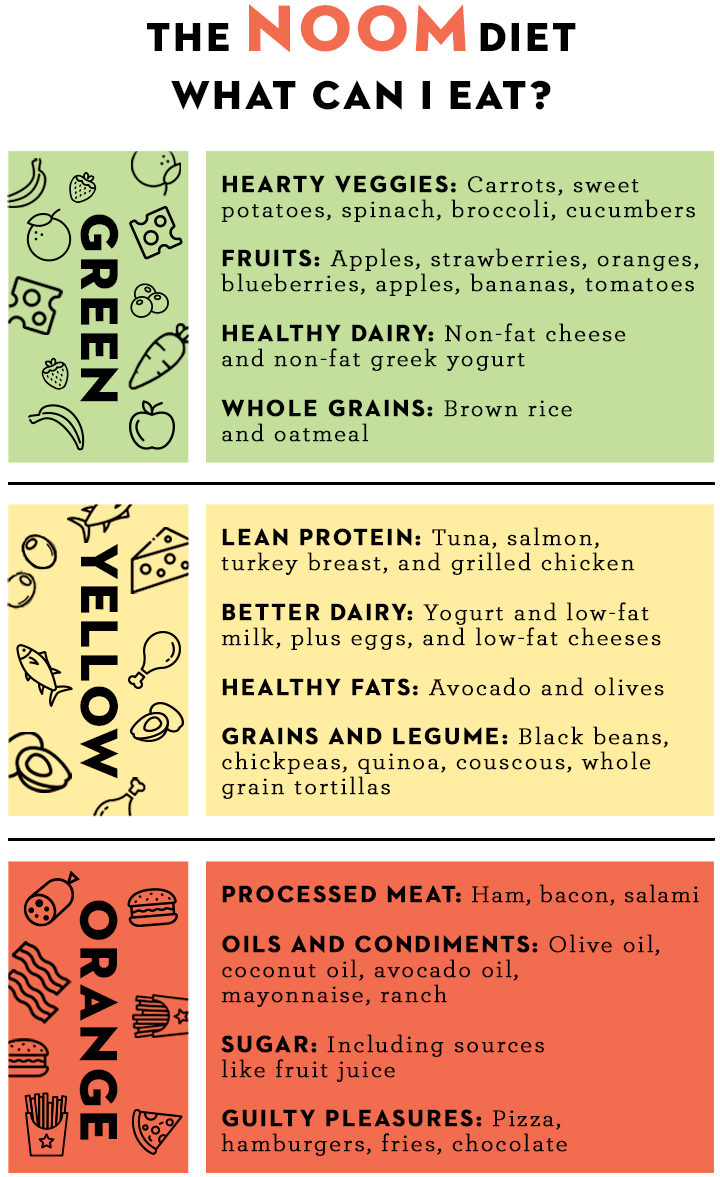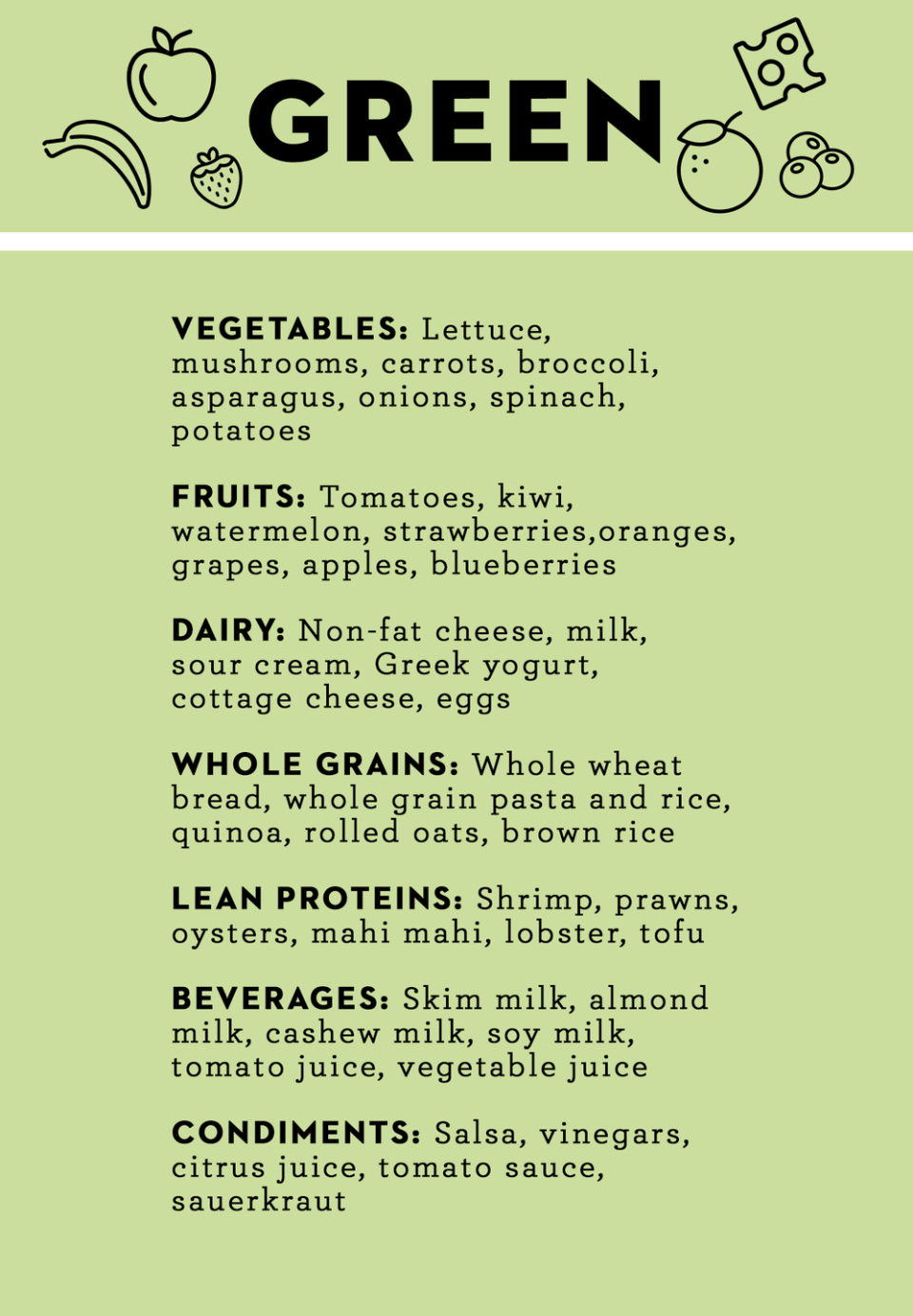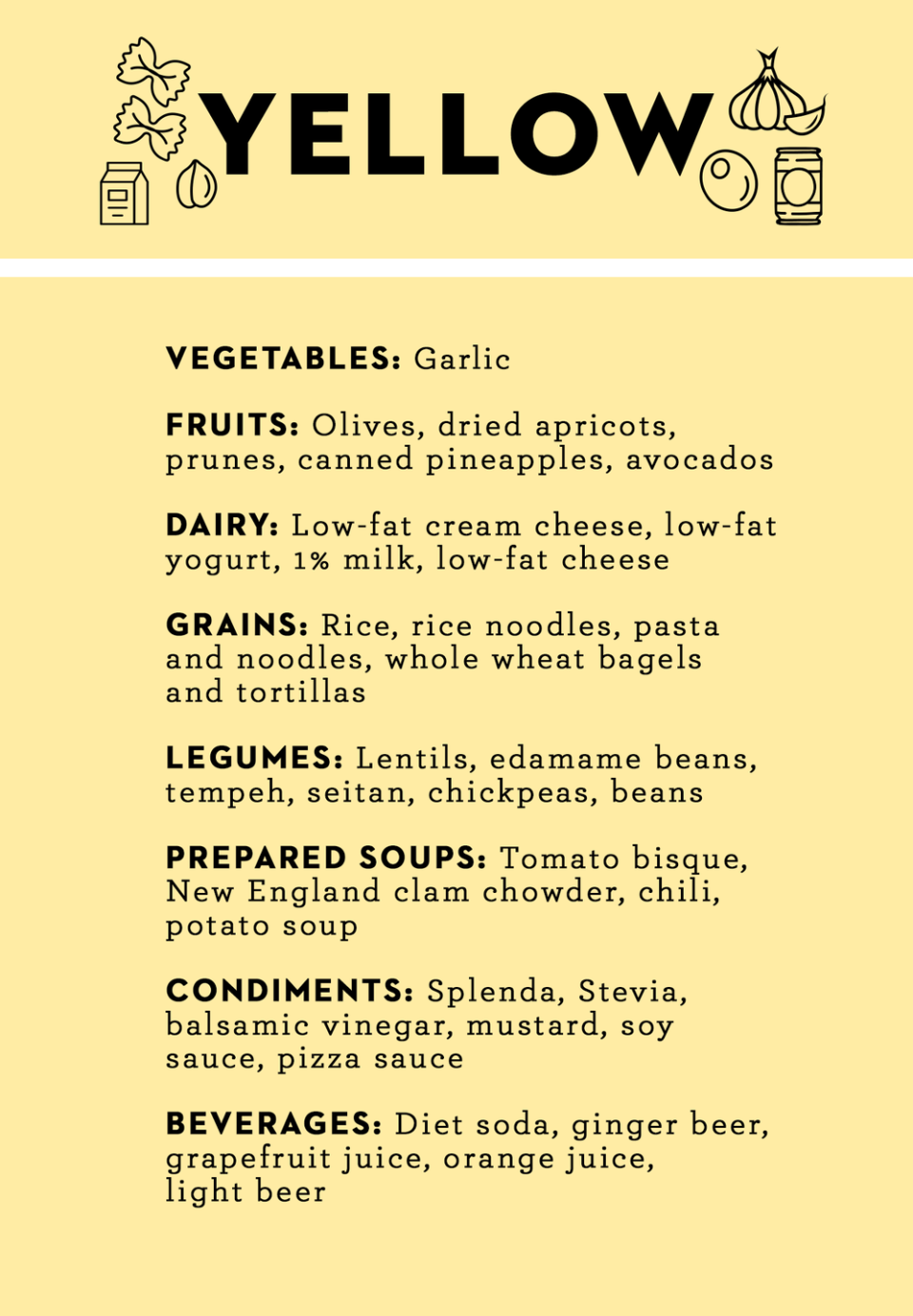Breaking Down Noom's Complex Color-Coded Diet Program

"Hearst Magazines and Yahoo may earn commission or revenue on some items through the links below."
Noom has earned a mixed reputation over the last few years, with some users purporting that its services may lead to a fractured relationship with food — while other wellness experts (including our own nutritionist) recognize its attempts to promote wholesome eating habits for any user. Referred to as "Noomers" by brand officials, dieters who use Noom Weight (as opposed to its mental health-adjacent service, Noom Mood) are familiarized with nutrition basics through a proprietary system that categorizes grocery staples into a color-coded system. Foods are sorted into green, yellow and a recently created orange category, which are designed to help make counting calories a bit more intuitive.
First developed by a team of psychologists, the Noom diet aims to prioritize long-term lifestyle shifts rather than short-term fasts or cutting out entire food groups (a la Keto). Noom connects users to live coaches and allows them to receive many forms of 1-on-1 coaching during business hours. A Noom representative tells Good Housekeeping that it also encourages users to track holistic health measurements like blood pressure and blood glucose through in-app tools, "to help them assess how their nutrition choices are impacting their goals."

The program also includes an assessment portion for new users to help establish broader health goals, including potential diabetes management plans; Noom Weight users usually opt-in for a 4-month auto-renewing subscription at $159, or just about $40 monthly.
But how exactly does Noom encourage weight loss if it doesn't restrict any ingredients? It all has to do with a color-coded system that may be slightly altered for each user based on instructions from their coaches and any personal health assessments.
Editor's note: Weight loss, health and body image are complex subjects — before deciding to go on a diet, we invite you to gain a broader perspective by reading our exploration into the hazards of diet culture.
What can you eat on the Noom Diet?
Like Weight Watchers and other popular paid weight loss services, the Noom app helps you lose weight by asking you to track your meals. It measures the caloric value of every item you input while comparing it to exercise and other physical movements you've completed during the day, as well as weighing both those factors against your personal goals. While Noom aims to keep your body fueled with sufficient calories, it doesn't technically restrict you from eating any ingredients or food groups.

But as Stefani Sassos, M.S., R.D., C.D.N., deputy director of the Good Housekeeping Institute's Nutrition Lab, points out in her formal review of the service, achieving weight loss usually only occurs when a Noom user moderates highly caloric, sugary and processed snacks. Noom doesn't push a strict regiment by any means, but the app rewards you for eating wholesome, nutrient-dense foods through its color-coding system. Even when you do eat a meal that's less nutritionally dense, the app will try to help you reduce dietary blowback by encouraging portion control for certain ingredients that come up in orange. It may also reward you for indulging in foods that are categorized as green, while expecting that you incorporate many yellow-coded items into most of your meals.
This color system, which has been recently updated, is meant to act as a general guide for Noom dieters who may be new to the program, as an updated take on calorie targeting. Users are encouraged to consume a bulk of their calories from the program's yellow category, about 45%; up to 30% of more from its green category and a smaller 25% from its orange category.
It's important to remember that orange foods aren't "bad" and green foods can also be considered unhealthy in copious amounts. If you're stuck trying to decide what to buy or eat, using Noom's color-coded list may help you make the best decision in the spur of the moment.
Noom's Green Foods List:

What you should double down on:
Non-Fat Dairy: Greek yogurt, cottage cheese, cheese, milk, sour cream
Hearty Vegetables: Carrots, sweet potatoes, spinach, broccoli, cucumbers, lettuce, mushrooms, bell peppers, asparagus, green beans, onions, peas, Brussel sprouts, sweet potatoes
Fruits: Apples, strawberries, oranges, blueberries, apples, bananas, tomatoes, watermelon, grapes, raspberries, pineapple, pears, cherries, peaches, mango, figs
Whole Grains: Wheat bread, whole grain pasta, pita, and rice; quinoa, grits, brown rice, and barley, among others
Healthy Protein: Egg whites, shrimp, lean white fish, mahi-mahi, lobster, tofu
Condiments: Salsa, apple cider vinegar, sauerkraut, citrus juice, tomato sauce
Of course, the best foods to eat while on the Noom diet are designated in a bright green color — these items are fresh vegetables, nourishing fruits, wholesome grains, and supercharged dairy items that work in tandem to regulate your digestive system. You'll find that you can enjoy bigger portions of these nutritional powerhouses throughout the day, and the more that you incorporate into your meals, the closer you'll get to your daily, weekly, and monthly weight loss goals.
Noom's Yellow Foods List:

What you should enjoy in moderation:
Lean Protein: Steak, fish, turkey, chicken breast, pork, lamb, canned tuna, sushi
Fruits: Olives, dried apricots, prunes, canned pineapples, avocado, plantain
Dairy: Low-fat yogurt, 2% low-fat milk, low-fat cottage cheese, low-fat cheese
Snacks: Hummus, fruit cup, banana pancake, rice pudding, acai bowl
Beverages: Diet sodas, ginger beer, vodka soda, grapefruit juice, light beer, orange juice, fruit smoothie, unsweetened cranberry juice
Legumes: Lentils, edamame, baked and refried beans, tempeh, chickpeas
Condiments: Gravy, oyster sauce, cacao powder, balsamic vinegar, mustard, soy sauce, pizza sauce
While the app encourages you to eat fewer foods that are coded yellow, you may notice that these ingredients are healthy in their own right. Noom has designated these items as second-tier to foods on the green list only because they're denser in calories. This doesn't mean you should totally abstain from them, however; the app encourages you to incorporate lean proteins and other nutrient-rich items like tempeh into your meals, albeit in smaller amounts.
If you find yourself frequently reaching for items that are on the yellow list, Noom's app is designed to help find a green-list item that you can easily swap for instead. For example, you may swap chicken breast out for tofu in a meal every once in a while because Noom rewards tofu more than it does chicken breast.
Noom's Orange Foods List

What you should limit:
Fruits: Dates, raisins, dried cranberries
Grains: White bread, biscuits, pita bread, hot dog buns, flour tortillas, croissants, bagels, granola, saltines, waffles, muffins
Dairy: Butter, margarine, full-fat cheese, whole milk, half and half, cream cheese, cottage cheese, full-fat yogurt
Condiments: Olive oil, ranch dressing, sour cream, mayonnaise, ketchup, barbecue sauce, pesto, coconut milk, maple syrup, honey
Snacks: Nuts, tortilla chips, potato chips, crackers, popcorn, pretzels
Desserts: Sugar, dark chocolate, ice cream, cookies, cake, brownies, apple pie, candy, cheesecake, whipped cream
Beverages: Red wine, white wine, champagne, coffee creamers, hot chocolate, vodka, margarita, apple cider, mixed coffee drinks
As you've probably guessed, the foods that are tagged on Noom's orange list are staples that are high in calories, saturated fats, sodium, sugar, and processed carbohydrates. While you're not restricted from enjoying these items once every so often, they should be avoided and curtailed as much as possible on a routine daily basis. You may want to double up on foods found on Noom's green list throughout the rest of the day if you do enjoy more than a few servings of foods on the app's orange list, or spend a few more minutes in the gym, in order to stay on par with any weight loss goals.
The majority of 'orange' foods shouldn't shock you; highly-processed meats, like bacon, are often restricted on most diets. Some of these items may be surprising, however, such as peanut butter, which can be quite high in calories and (depending on the brand) added sugars or sodium. While each of the items on Noom's orange list varies in nutritional value, you can always make them better for your own diet by choosing the healthiest variety possible: Stick to dark chocolate, natural peanut butter or a sandwich made with low-sodium ham.
Is Noom safe to try?
In spite of any controversy surrounding the platform, experts within the Good Housekeeping Institute have previously noted that Noom focuses on changing dietary behaviors rather than pushing quick fad diets for unsustainable results.
Its coaching offerings are unique in the marketplace for those who may prefer a digital outlet rather than in-person meetings. Sasoss noted that she was impressed that Noom Weight includes a robust food database for tracking, which features a barcode-scanning feature that allows users to learn more about their favorite store-bought foods. This database includes information on dishes made by meal delivery services, such as Hello Fresh, for easier tracking on the go.
But it's also fair to note that the color system detailed above may easily lead users to vilify otherwise healthy foods based on their color status. Program officials indicate that the color system is designed to help create natural portion control, but users may easily associate green-labeled foods as being better than orange-labeled foods, or those seen as "bad" options. This line of reasoning may have influenced Noom to update its color system in 2022; previously, foods that were meant to be moderated highly were listed as 'red', which some believed purported a negative connotation.
If you have a history of disordered eating, Noom (and any other dietary program) is not recommended for you.
Ultimately, diet programs and paid apps like Noom Weight may be helpful for some, but they aren't guaranteed to work universally. If you're on the fence about joining the program, Noom Weight currently offers a 14-day trial for new users — a safe way to discover how interacting with its color-coded lists ends up making you feel.
You Might Also Like

